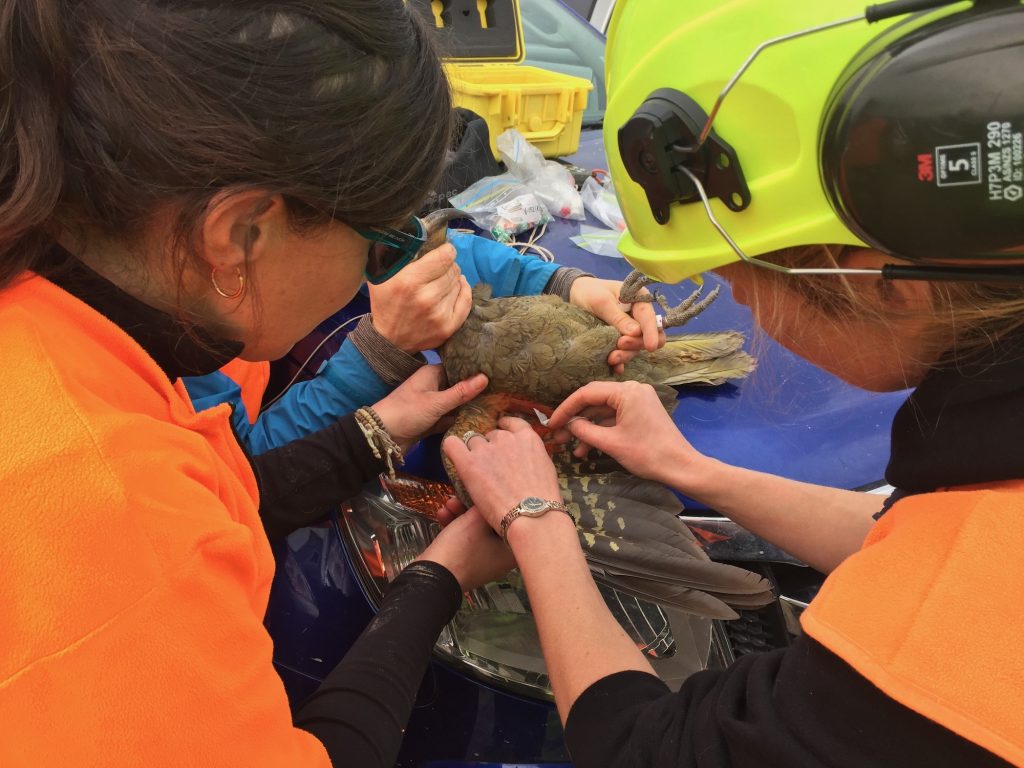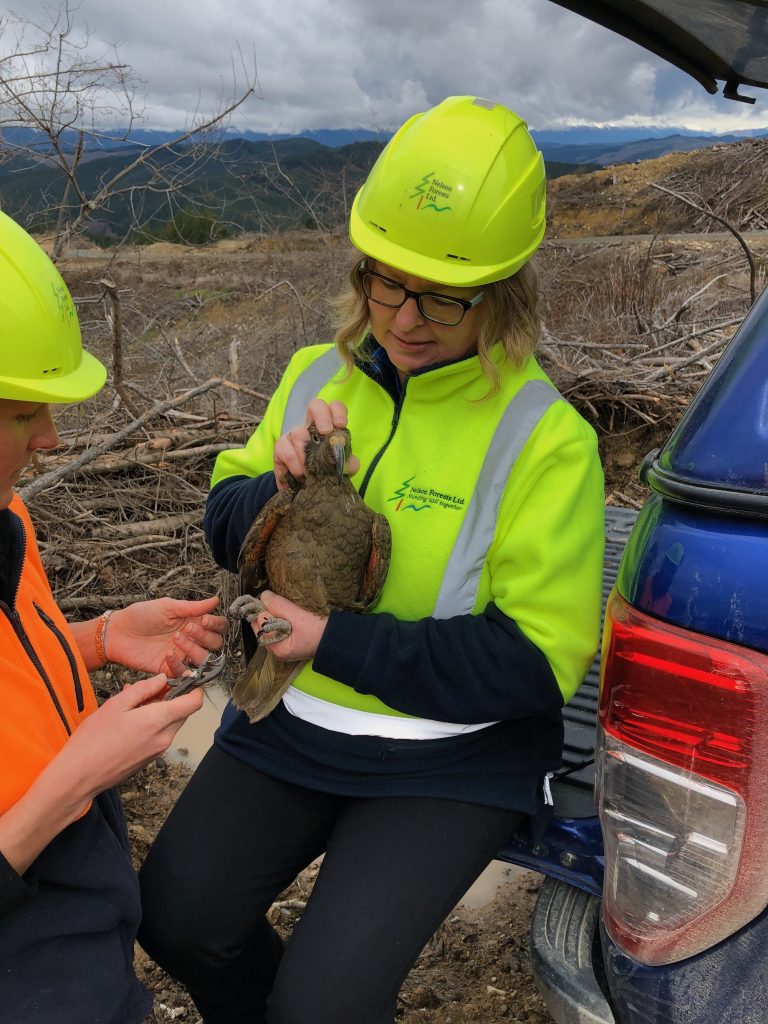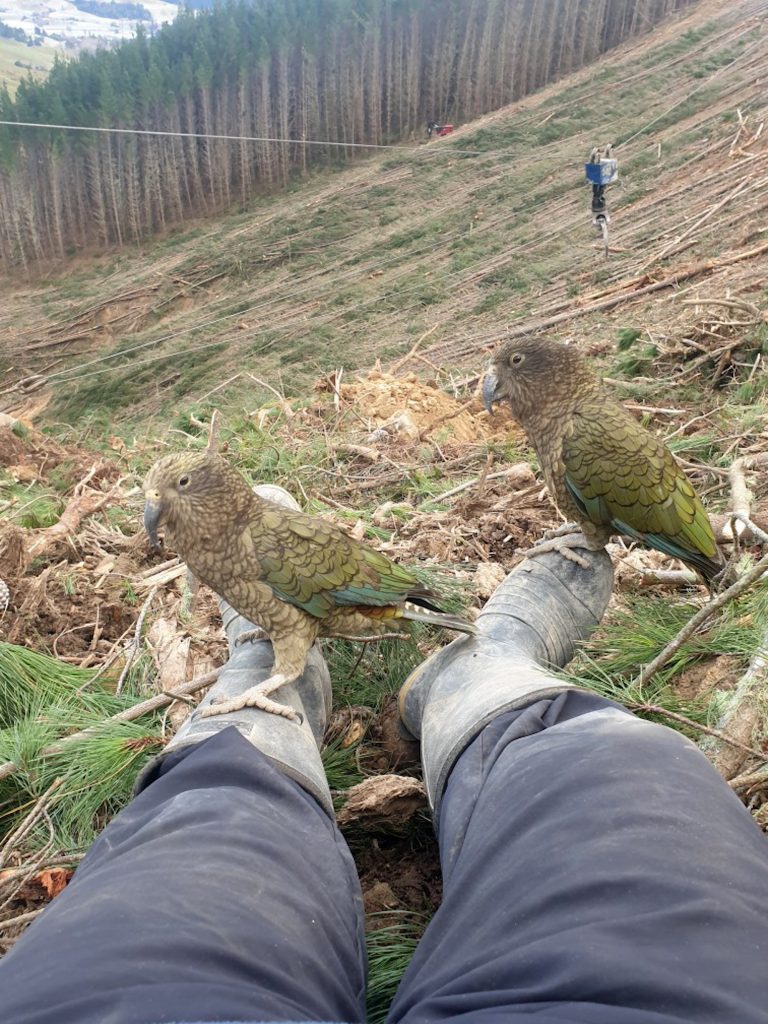
BY SANDRINE MARRASSÉ | PHOTOGRAPHY NELSON FORESTS and MECHANISED CABLE HARVESTING (MCH)
Seeing kea in the wild is a really special experience. They are beautiful birds; majestic yet playful, sociable and highly intelligent. As they fly, we’re treated to the beautiful blue and green markings that colour their wings and tail tip, and the stunning flash of vivid orange of their underwing. Named by Māori for the sound of its call, the kea is endemic to Aotearoa’s South Island and is the world’s only mountain parrot.
Kea have a number of memorable behaviour traits and most of us will readily recall the confident strut of the mischievous extrovert, seemingly tame in its demeanour, yet ready and willing to pose for that perfect Instagram photo.
Looking a little deeper into the life of kea, and coming to understand that the nationally endangered birds are ground nesters, reveals more about these beautiful parrots. “They’re on the ground and really vulnerable,” says Andrea Goodman, the Kea Conservation Trust’s Kea Conflict Management and Community Engagement Coordinator. “The female kea sits there quite quiet, just like a chicken. She’s not a gregarious clown that’s all bolshy and strong.”
The highly intelligent and social birds have an unusual tendency to seek out people and property. This leads to what the Kea Conservation Trust refers to as conflict. Kea are naturally attracted to human activity, particularly the buzz and action of working plantation forestry sites.
Nelson Forests sees its relationship with the Kea Conservation Trust as a long-term and vitally important one. They have worked together since 2014 to protect kea, at the same time endeavouring to ensure worker safety. Kea can be distracting and destructive on a worksite, so operating in kea-populated areas can be challenging.
It’s important to both organisations to understand how any human–kea conflict can be managed in a way that is mutually beneficial.
“Like the kiwi, kea are an iconic New Zealand species,” says Heather Arnold, Nelson Forests’ Environmental Planner. “However, most people don’t realise that there are fewer than 5000 kea left, compared with 68,000 kiwi.”
Starting this year, Nelson Forests is providing funding to the Trust as part of a five-year programme to help support kea conservation. The funding will support the Conflict Transformation Programme, a citizen science research programme that will strive to establish how important plantation forestry is to kea by using kea sightings and data from Nelson Forests’ staff and contractors to contribute to the project, and a third research programme that supports kea in situ.
“We are in a stage of transitioning from managing human–kea conflict and trying to come up with avoidance tactics, to being a lot more proactive about trying to understand how important plantation forestry is for kea survival and habitat, and what we can do to create a good balance between our achieving productive land use, and helping the kea thrive in their habitat for the long term,” says Heather.

Vital funding
Part of the Nelson Forests funding will go towards human–kea conflict transformation work that is currently active in the Top of the South. “It’s about changing people’s perception of kea and also making sure that people can live with kea in their backyards, and ensuring that people such as those working in harvesting crews can work safely with kea,” says Andrea. “That’s huge for the industry as well – given that they value safety so highly.
“The forestry industry as a whole has just been terrific with their response to kea conservation in the South Island. Nelson Forests, in particular, has really jumped on board and Heather Arnold has been instrumental in encouraging the ethos of kea conservation within harvesting crews and the wider Nelson Forests business.”
In addition to programme funding, Nelson Forests will also contribute in-kind support towards developing, trialling and assessing a variety of kea-proofing strategies and tools to be employed at forestry and other work sites.
“I get regular phone calls from contractors to let me know ‘hey, we’ve got kea here’, so we roll out the standard things that have proved to work,” says Heather. “The first and biggest rule being never to feed kea, and then other practical things like covering vehicles and precious items with blue tarpaulins.
“Kea don’t like garlic paste so we suggest the crews smear it over their key wires as the birds like to strip the plastic housings to play with the wires underneath. If it’s a crew that hasn’t already had a discussion with Andrea from the Kea Conservation Trust, I’ll ask her to come and talk to the crew about how precious kea are and what we need to do to look after them, and how we can minimise those areas of conflict.
“Building on our long-term work with the Trust, we’ve just started the citizen science research programme that has been designed to try to understand the interface between plantation forestry and kea habitat. Part of this project is kea banding, which is also partly funded by the New Zealand Forest Owners’ Association. This project is really reliant on timely reporting from our workforce in the forest.”
The kea are captured and banded with leg tags. The Kea Conservation Trust and DOC use the opportunity while the kea are captive to take blood samples from them that test for lead levels. Colour banding of kea provides important re-sighting opportunities, which will contribute to a database of information on individual kea survival, social affiliations, movement and status of populations over time.
“We are trying to band as many birds as we can within plantation forest and harvesting sites, look at where they are going, and find out if it’s the same kea that are visiting multiple sites,” says Andrea. “We can also track and monitor which kea are pairing up, but we’re also testing them for lead levels. Lead is a really big factor in kea mortality. Kea get lead from many places. They get it from old roofs, they’re picking off the lead nails and the lead flashing, and old paint, and they’re also getting it from dump sites. We’re finding that kea have really high lead levels in places like Arthur’s Pass and on the
West Coast.”

Mapping kea sites
In-kind support from Nelson Forests includes reporting kea sightings and their banding colours. If unbanded birds are spotted, Nelson Forests staff and contractors alert the Trust so that they can come and band those birds. This information contributes to GIS mapping of the kea conflict locations and will be disseminated via the Kea Conservation Trust website and shared with crews at the sites as well.
This research will benefit the local kea and the human communities who are living with kea around them. Kea sightings can be logged at www.keadatabase.nz.
The Kea Conservation Trust in conjunction with Nelson Forests and other local forestry companies have drafted the Kea and Forestry Guidelines, which have been endorsed by the Forest Owners’ Association and distributed to harvesting crews throughout the South Island. It gives forestry personnel an understanding of what to do if there are kea in the area and what they should do if they come across kea, such as how to behave, what their environmental responsibilities are, and what the protocols are if they see evidence of nesting kea.
“The forestry industry has been really proactive as opposed to reactive – and it’s worked,” says Andrea. “We have had examples where we have found a kea nest on a harvest site and the guidelines were followed to the letter.
“The work we’ve been doing is showing that plantation forestry clearly plays an important role in kea conservation.”
Just how important a role is a big question still to be answered. Andrea and Heather hope that the upcoming research programme will contribute to existing knowledge and help ensure an enriched and sustainable future for our precious wild kea.
